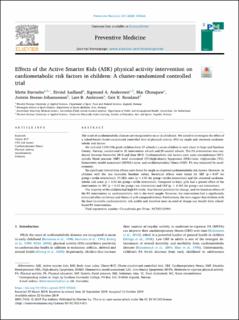| dc.contributor.author | Stavnsbo, Mette | |
| dc.contributor.author | Aadland, Eivind | |
| dc.contributor.author | Anderssen, Sigmund Alfred | |
| dc.contributor.author | Chinapaw, Mai | |
| dc.contributor.author | Steene-Johannessen, Jostein | |
| dc.contributor.author | Andersen, Lars Bo | |
| dc.contributor.author | Resaland, Geir Kåre | |
| dc.coverage.spatial | Norway, Sogn og Fjordane | en_US |
| dc.date.accessioned | 2020-03-26T09:09:20Z | |
| dc.date.available | 2020-03-26T09:09:20Z | |
| dc.date.created | 2020-01-15T13:17:07Z | |
| dc.date.issued | 2019 | |
| dc.identifier.citation | Stavnsbo, M., Aadland, E., Anderssen, S. A., Chinapaw, M., Steene-Johannessen, J., Andersen, L. B., & Resaland, G. K. (2020). Effects of the Active Smarter Kids (ASK) physical activity intervention on cardiometabolic risk factors in children: A cluster-randomized controlled trial. Preventive Medicine, 130. | en_US |
| dc.identifier.issn | 0091-7435 | |
| dc.identifier.uri | https://hdl.handle.net/11250/2648772 | |
| dc.description.abstract | The onset of cardiometabolic diseases are recognized to occur in childhood. We aimed to investigate the effect of a school-based cluster-randomized controlled trial of physical activity (PA) on single and clustered cardiometabolic risk factors. We included 1129 fifth-grade children from 57 schools (≥seven children in each class) in Sogn and Fjordane County, Norway, randomized to 28 intervention schools and 29 control schools. The PA intervention was conducted between November 2014 and June 2015. Cardiometabolic risk factors were waist circumference (WC), systolic blood pressure (SBP), total cholesterol (TC):high-density lipoprotein (HDL)-ratio, triglycerides (TG), homeostatic model assessment (HOMA)-score, and cardiorespiratory fitness (CRF). PA was measured by accelerometry. No significant intervention effects were found for single or clustered cardiometabolic risk factors. However, in children with the less favorable baseline values, beneficial effects were found for SBP (p = 0.07 for group ∗ tertile interaction), TC:HDL ratio (p = 0.03 for group ∗ tertile interaction) and the clustered cardiometabolic risk score (p = 0.01 for group ∗ tertile interaction). Compared to boys, girls had a greater effect of the intervention on WC (p = 0.03 for group ∗ sex interaction) and CRF (p < 0.001 for group ∗ sex interaction). The majority of the children had high PA levels, thus limited potential for change, and we found no effects of the PA intervention on cardiometabolic risk in the total sample. However, the intervention had a significantly enhanced effect on fatness and fitness of girls compared to boys. Furthermore, the data suggest that children with the least favorable cardiometabolic risk profile and therefore most in need of change can benefit from school-based PA interventions. | en_US |
| dc.language.iso | eng | en_US |
| dc.rights | Attribution-NonCommercial-NoDerivatives 4.0 Internasjonal | * |
| dc.rights.uri | http://creativecommons.org/licenses/by-nc-nd/4.0/deed.no | * |
| dc.subject | cluster RCT | en_US |
| dc.subject | CVD risk factors | en_US |
| dc.subject | cardiorespiratory fitness | en_US |
| dc.subject | physical activity | en_US |
| dc.subject | accelerometry | en_US |
| dc.subject | pediatric | en_US |
| dc.title | Effects of the Active Smarter Kids (ASK) physical activity intervention on cardiometabolic risk factors in children: A cluster-randomized controlled trial | en_US |
| dc.type | Peer reviewed | en_US |
| dc.type | Journal article | en_US |
| dc.description.version | publishedVersion | en_US |
| dc.rights.holder | © 2019 The Authors. | en_US |
| dc.source.pagenumber | 8 | en_US |
| dc.source.volume | 130 | en_US |
| dc.source.journal | Preventive Medicine | en_US |
| dc.identifier.doi | 10.1016/j.ypmed.2019.105868 | |
| dc.identifier.cristin | 1773763 | |
| cristin.ispublished | true | |
| cristin.fulltext | original | |
| cristin.qualitycode | 2 | |

